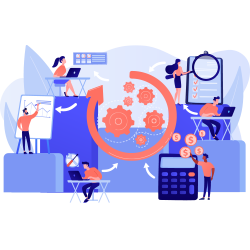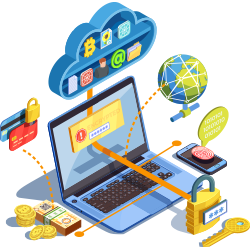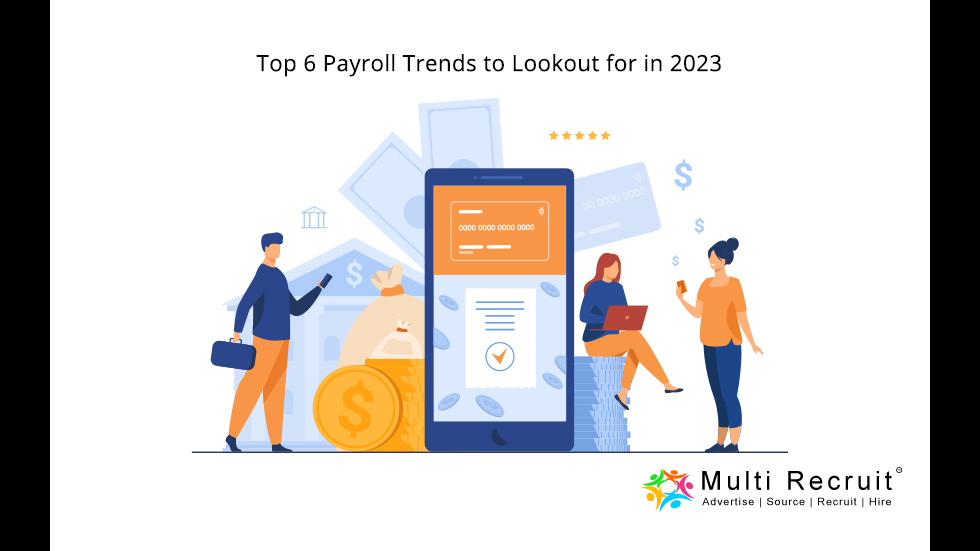The process of payroll goes far beyond simply calculating an employee’s paycheck. A good payroll policy is essential for motivating and involving employees.
It is not only the pay that determines how involved an employee is in the company; however, it also indicates what level the employee is at in the organization. It is, therefore, imperative to advocate for better payroll policies to motivate and engage employees.
Payroll is much more than just calculating an employee’s salary. These trends will make headlines this year and help businesses recruit and retain more employees.
Explore the Top 6 Payroll Trends to Look out for in 2023
The top 6 payroll trends to look out for in 2023 are:

1. Simple, secure, and fast salary payments with direct bank integrations
There used to be a difference between the payroll software used by companies and the payroll software used by banks. The areas of operation of the two companies were completely different, despite regular transactions between them. Payroll software must coordinate with banks to process salary payments, resulting in longer turnaround times.
The introduction of technology has made business and payroll processes simple, time-saving, and effective for both businesses and entrepreneurs. In recent years, banks have had a greater chance to interact directly with entrepreneurs and MSMEs, which are the most reliable sources of regular cash flow. There is a high likelihood of this trend continuing and growing.

2. A meaningful automation process
The payroll department needs to be automated in a meaningful way. This does not refer to the introduction of a broader system of automation, such as automatic salary and tax computation.
It involves automating the smaller, manual tasks that take your payroll department the most time. Even the simplest of tasks takes a considerable amount of time when we are accustomed to the old, outdated system.
As a result of automation, you can free up valuable time in your department and concentrate on more productive tasks. A payroll department can become more productive and reduce turnaround times with auto-generated compensation reports.

3. A personalized employee experience
Payroll and HR departments should ensure that their technology adapts to employees’ devices to solve the challenges of personalization. There is no doubt that mobile devices have become an integral part of people’s lives.
In this age of mobile devices, self-service systems that can be accessed on mobile devices are essential to helping employees view their payslips, swap shifts, and view their performance histories.
These systems can help the company manage payroll and HR issues in real time and provide effective solutions. Additionally, mobile self-service helps companies create a positive working relationship with employees and personalize the employee experience.

4. Compliance with design
The process is made even more complicated by the unique tax laws and labor laws in each region. The country has several small businesses and several businesses that operate in several states. Therefore, companies may find it challenging to comply with local financial laws and regulations.
Data-driven compliance systems have been introduced with advancements in payroll technology. They have access to all the necessary information to follow compliance in various regions of the country. Staying on top of changes in regulations helps businesses avoid legal risks and remain compliant.

5. A payroll strategy that leverages rich data insights
A company’s payroll is one of its most crucial functions. Despite this, the service delivery timeline still faces various challenges and opportunities for improvement. To effectively manage payroll results and processes, companies often rely on manually generated analytics.
The HRMS and automated payroll systems offer rich data insights that can be used for dedicated analytics. By defining Key Performance Indicators, you can improve the efficiency of payroll functions. In addition to improving processing timelines, dashboards can also reduce error rates.

6. Utilization of cloud computing
Businesses have become increasingly dependent on cloud systems. In addition to solving crucial business issues, they also help to handle payroll functions efficiently. A small group of employees in many companies usually uses traditional payroll solutions like spreadsheets and customized software. In addition to fulfilling the most basic payroll functions, the system supports several other functions as well.
Payroll systems that are cloud-based integrate accounting and HR so that you can collaborate in real-time and create more robust integrations. Using conversational chatbots, for instance, the company can provide employees with better context and accuracy when they have questions in real-time. To integrate payroll functions, companies need to use cloud technology.
CONCLUSION
As the top payroll service providers in India, we focus on finding right solutions for our clients. Our team integrates into a business, identifies payroll issues, and recommends a solution. If any payroll services doesn’t fit your business, we won’t recommend it to you after understanding your problems. Our team even offers outsourced payroll services if you prefer to let someone else handle it.
You can count on us to be your true business partner, and we’ll work with you to create lasting, meaningful change within your payroll and HR team and organization as a whole. Click here to learn how you can partner with us.
Your content goes here. Edit or remove this text inline or in the module Content settings. You can also style every aspect of this content in the module Design settings and even apply custom CSS to this text in the module Advanced settings.

